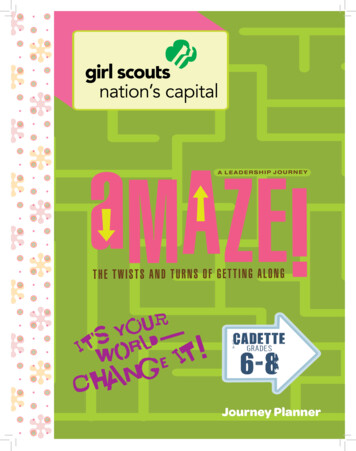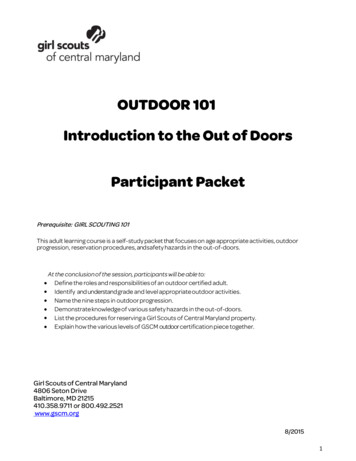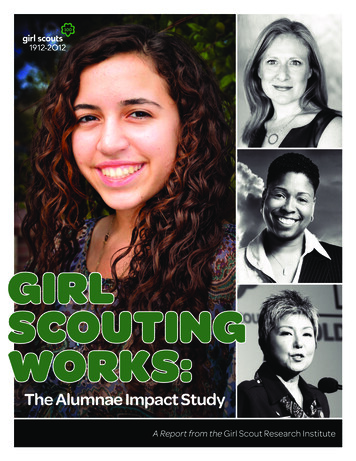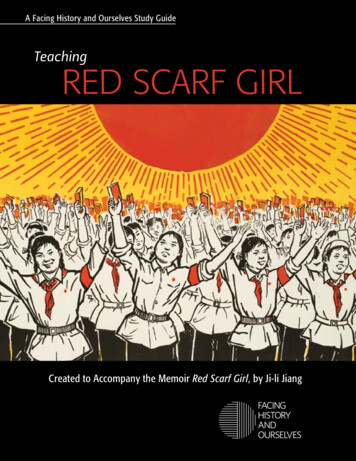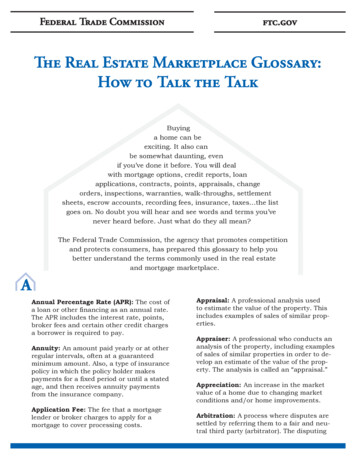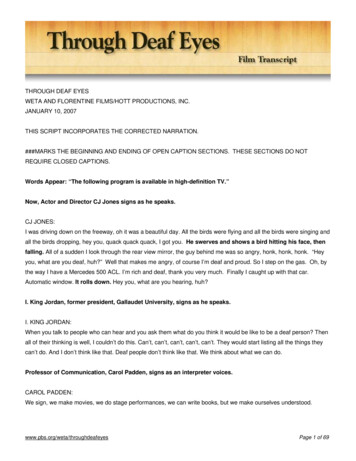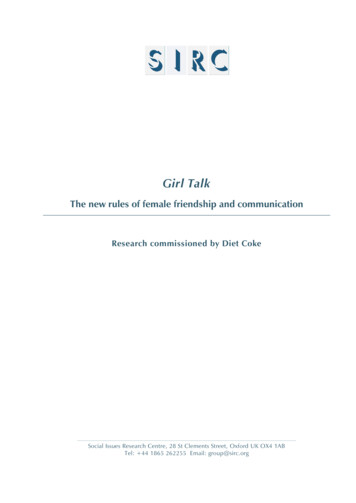
Transcription
I RcGirl TalkThe new rules of female friendship and communicationResearch commissioned by Diet CokeSocial Issues Research Centre, 28 St Clements Street, Oxford UK OX4 1ABTel: 44 1865 262255 Email: group@sirc.org
Girl TalkContentsPreface: The nature of friendship. . . . . . . . . . . . . . . . . . 4Introduction. . . . . . . . . . . . . . . . . . . . . . . . . . . . . 6The gender in the ascendent . . . . . . . . . . . . . . . . . . . . . . 6Women in their mid twenties to mid thirties – Some facts and figures . . 7The research process . . . . . . . . . . . . . . . . . . . . . . . . . . 8The Findings . . . . . . . . . . . . . . . . . . . . . . . . . . . . 9The nature of women's Friendship . . . . . . . . . . . . . . . . . . . . 9Women and their friends. . . . . . . . . . . . . . . . . . . . . . . . 11The close/best friend . . . . . . . . . . . . . . . . . . . . . . . . . . . . 11The opposite sex friend . . . . . . . . . . . . . . . . . . . . . . . . . . 13The gay male friend . . . . . . . . . . . . . . . . . . . . . . . . . . . . 15Gender stereotypes? . . . . . . . . . . . . . . . . . . . . . . . . . . . . 15Generations of women. . . . . . . . . . . . . . . . . . . . . . . . . . . 16Making friends . . . . . . . . . . . . . . . . . . . . . . . . . . . . . . . 17The workplace . . . . . . . . . . . . . . . . . . . . . . . . . . . . . . . 18Keeping in touch. . . . . . . . . . . . . . . . . . . . . . . . . . . . . . 20The new rules of women's friendships . . . . . . . . . . . . . . . . . 23Girl talk: Women's secret – or not so secret – language. . . . . . . . . 25The theories . . . . . . . . . . . . . . . . . . . . . . . . . . . . . . . . 25Girl talk: Gossip and secrets . . . . . . . . . . . . . . . . . . . . . . 28Gossip or chat? . . . . . . . . . . . . . . . . . . . . . . . . . . . . . . 28'Bitching' . . . . . . . . . . . . . . . . . . . . . . . . . . . . . . . . . . 29Functions of gossip. . . . . . . . . . . . . . . . . . . . . . . . . . . . . 32Secrets . . . . . . . . . . . . . . . . . . . . . . . . . . . . . . . . . . . 33Successful working women . . . . . . . . . . . . . . . . . . . . . . . 35Role models . . . . . . . . . . . . . . . . . . . . . . . . . . . . . . 37The 'perfect' man? . . . . . . . . . . . . . . . . . . . . . . . . . . . 40Summary and conclusions. . . . . . . . . . . . . . . . . . . . . 43Women's friendships . . . . . . . . . . . . . . . . . . . . . . . . . . . . 432The Social Issues Research Centre
Girl TalkWomen's work friendships . . . . . . . . . . . . . . . . . . . . . . . . . 43The rules of women's friendships. . . . . . . . . . . . . . . . . . . . . . 43Women's 'secret' language . . . . . . . . . . . . . . . . . . . . . . . . . 44Gossip . . . . . . . . . . . . . . . . . . . . . . . . . . . . . . . . . . . 44Secrets . . . . . . . . . . . . . . . . . . . . . . . . . . . . . . . . . . . 44Success at work for women . . . . . . . . . . . . . . . . . . . . . . . . 45Role models . . . . . . . . . . . . . . . . . . . . . . . . . . . . . . . . 45The perfect man . . . . . . . . . . . . . . . . . . . . . . . . . . . . . . 45Conclusion. . . . . . . . . . . . . . . . . . . . . . . . . . . . . . . . . 45The Social Issues Research Centre3
Girl TalkPreface: The nature of friendshipBy Kate Fox1Homo sapiens is a social animal. As a species, we are designed to live in small,stable, close-knit tribes or communities. In modern Western cultures, since theindustrial revolution, there has been a significant rise in social isolation – in thefragmentation of traditional communities and kinship networks. More of us areliving alone, often in big cities, working long hours and experiencing a profoundsense of alienation and insecurity. But the need for social bonding, the 'tribal'instinct, is a deep-rooted part of human nature, hard-wired into the human brainby our evolutionary heritage, and there is convincing evidence that individuals inpost-industrial societies are striving to re-create these community bonds, forming'neo-tribes' and 'pseudo-kin' relationships.These new social support networks are often based on shared interests or values,rather than kinship or local ties, but they effectively mimic the traditionalkin/community networks. This trend, which I have called The New Collectivism, isparticularly evident among young people, who are increasingly pre-occupied witha need for security and a sense of belonging – an intense, albeit often unconscious,longing for more primitive, pre-industrial patterns of social ties, interdependence,cooperation and social cohesion.This longing may perhaps be even more acute among young women than youngmen, as the female of the human species is, if anything, even more 'social' than themale. Studies consistently show that women are more proficient than men at allforms of communication – verbal and non-verbal – more socially skilled, better atspotting and 'reading' the nuances in people's reactions and behaviour andgenerally more interested in people and relationships. This is evident even amongnew-born babies, before social conditioning could possibly have any effect. Babygirls, from as young as a few hours old, are more attracted to faces, while babyboys are more interested in looking at shapes and patterns – and baby girlsmaintain eye contact two or three times longer than boys.The nature of human friendship reflects the fact that for almost all of our evolutionas a species we were hunter-gatherers. With division of labour, men hunted,women gathered. As far as evolution is concerned, modern industrial societiesonly happened in the last ten seconds or so on the evolutionary clock and really donot count. Human brains and behaviour are shaped by millions of years as huntersand gatherers and the basic wiring is still the same as it was in the UpperPalaeolithic period – the Stone Age.Male bonding was absolutely essential for hunting. Hunting requires teamwork,which requires cooperation and, above all, trust. Male bonding was all aboutbuilding that trust. This was also essential for warfare – our ancestors werefighters as well as hunters. Men who were not necessarily related to each otherhad to form bonds that were strong enough for them not only to hunt together14Author of Watching the English: The hidden rules of English behaviour. Hodder and Stoughton,2005.The Social Issues Research Centre
Girl Talkeffectively but also to trust each other with their lives in tribal warfare – andultimately to die for each other if necessary.Females, as gatherers and with responsibility for bearing and raising children, alsohad a critical need to build cooperation and trust with other females. A woman inchildbirth or with young babies was highly vulnerable and in need of protectionand support – cooperation with other females, both in gathering food and inchildcare, was essential to survival. Female bonding in hunter-gatherer societieswas mostly of a more ad-hoc, informal, less organised type than the male variety,conducted alongside other tasks such as gathering fruits and roots, preparing food,looking after children etc., rather than as a separate, ritualised activity. And whiletrust was essential, it was perhaps somewhat less of a dramatic life-or-death matterthan trust among male hunters and warriors. Female friendship – based oncooperation, reciprocal helping and sharing of day-to-day tasks – andchild-minding, providing care and support around childbirth, during illness and atother 'weak' or defenceless times, required a different kind of trust: not so much 'Iwill risk my life for you' as 'I will care for you'.Although we no longer face the same dangers or lead the same harsh lives as ourStone Age ancestors, all the same bonding instincts are still in place, andfriendship is still a vital part of our lives – perhaps increasingly so in this age ofurban alienation and anomie. Despite significant blurring of the distinctionsbetween male and female roles in modern society, 'male bonding' and 'femalebonding' are in still in some ways quite different. Male bonding tends to be moreformal and organised – every known human society has some form of men-onlyclubs or associations, special (often secret) male-bonding organisations orinstitutions from which women are excluded. Female bonding tends to be donemore quietly and informally than the male variety, without all the fuss and botherand setting up of fancy clubs. Women just bond: we don't seem to need all theprops and trappings, pomp and ceremony, sports and secrecy and silly names andfunny handshakes. All women need for bonding is a couple of chairs and a pot oftea – maybe not even that.The similarities between male and female friendships are, however, moreimportant than the differences. For both sexes, friendship always was, and still is,a form of reciprocal altruism that assimilates non-kin to kinship roles. In otherwords, it is a kind of give-and-take sharing and trust-building by which peoplewho are not related become honorary brothers and sisters.It is not surprising, therefore, that in the SIRC study both male and femalerespondents emphasised trust and loyalty, always 'being there' for each other and'being oneself' as the principal and most vital elements of friendship. This is thekind of unconditional acceptance, allegiance and support that is normallyassociated with family, but that we also expect from our 'honorary' brothers andsisters, our friends.It has perhaps become a bit of a cliché to say that 'friends are the new family' –and although there is some truth in this statement, it is a bit too glib and notentirely accurate. Friends have always been a kind of family – friendship hasalways been about treating non-kin as though they were blood relatives. There isnothing new in this: we have been doing it since the Stone Age.The Social Issues Research Centre5
Girl TalkIntroductionThe gender in the ascendent"You can be what you want these days I think women can justchoose" 1The current generation of 25-35 year old women have reaped many of the rewardsof battles won by their mother's generation. At the start of 2007, post Sex in theCity and Bridget Jones, they are talking the talk and walking the walk – votingwith their feet and delaying marriage, motherhood and mortgages. With moreopportunity, more freedom, more choice and higher disposable incomes, they livetheir lives confident in the knowledge that they are equal to men – if still notalways in practice.Better educated, more motivated and driven, they change jobs, homes, interests,lifestyles and make/break and collect friends as they go. These circles of friendsprovide support networks – security and a source of refuge – but also an escape, aplace to be themselves and have fun. The now rather tired adage that 'friends arethe new family' applies to this generation perhaps more than any other. As we willsee, however, the results of our research suggest that friends are no longer just thenew family and the functions that friendships play are increasingly complex.For women friends play many roles, helping them to define themselves atparticular stages in their lives. Women aged between 25-35 in particular valuetheir friendships a great deal – investing time, commitment and emotion in themand expecting the same in return. More women of this generation have been touniversity or college. This, and the end of ‘jobs for life’,2 mean that they haveboth the need and opportunity to build up large social networks which fulfilldifferent aspects of themselves. The complement might include: the circle ofclosest 'count-them-on-one-hand' friends, work friends, Sunday lunch friends,'activity' friends, the life-coach friend, the drinking buddy, the shopping friend,the once-in-a-blue-moon friend, the old school friend, the gay male friend .These 25-35 year old women are also reacting against both the ‘have it all’ mantraand the Bridget Jones stereotyping of their slightly older 'sisters'. As we will see,our research also shows that this generation, despite being inclined to "drivearound to find a copy of Heat" (as one participant put it), are reticent when itcomes to naming inspirational women in our celebrity-obsessed culture. Indeed,when we asked our female focus group participants and national poll respondentsto identify high profile women they admired, from a list including Hillary Clinton,Margaret Thatcher, Condolezza Rice, Judy Dench, Dawn French and Jordon, asignificant number chose 'none of the above', preferring instead to count theirmothers, female friends or colleagues as role models.Our research indicates that this is a mainly a generation of smart, independent anddriven women who do not – and don't want to – fit into marketeer's boxes.126All unattributed quotes are verbatim extracts from the focus groups and interviews.The Office for National Statistics reports that 25 year olds today are on average likely to have hadfour jobs, compared with only two in 1987.The Social Issues Research Centre
Girl TalkWomen in their mid twenties to mid thirties – Some facts and figuresC According to the National Statistics Office (NSO) women are having children later. The average age atchildbearing for women born in the late 1970s onwards is projected to be 29. The averagechildbearing age for women born in the 1940s was 23.8.C Women are also having fewer children. Family size has decreased from 2.03 children for women bornin the mid 1950s to a projected 1.75 children per family for women born in the mid 1980sC The number of women gaining two or more GCE A Levels increased from 20% to 45% between 1991-2and 2004, in comparison with an increase from 18% to 35% among males during the same period.C According to the Labour Force Survey (2004) 20% of women aged between 25 and 34 had a degree ofequivalent, compared with 15% of 35-44 year-olds and 8% of women aged 16-34. 22% of men aged25-34 had a degree or equivalent.C In the same survey, 10% of women aged 25-34 had no qualifications, and 29% had no GCSE gradesA-C or equivalent.C NSO data show that men and women continue to follow very different employment paths in the UK.Many more women are involved in part-time work than men, and men are twice as likely to beemployed in skilled trades or in senior management positions. However, the wage gap between menand women is becoming smaller, with women's average hourly pay at 83% of men's in 2005, comparedwith 74% in 1985.C According to the ASHE Survey 2004, the average wage of women aged 22-29 was 10.00, comparedwith 6.22 for women aged 18-21 and 12.48 for women aged 30-39. The average wage for men aged22-29 was 10.66.C The average wage of women with degrees working part-time was 13.47, compared to 5.67 forwomen with no qualifications.C According to Inland Revenue Statistics for 2002, the median income for women aged 25-29 was 17,200; for women aged 30-34 the median income was 18,700. Men in the same age groups earned 20,100 and 25,800 respectively.C The average disposable income for women in 2002-3 was 114 per week, compared with 203 perweek for men.C In 2002-3 the median gross individual income for women aged 20-24 was 162 per week comparedwith 225 per week for 25-29 year olds and 213 per week for 30-34 year olds. Women aged between25 and 35 represented the age groups with the highest amount of gross individual income.C According to the Labour Force Survey (2004), 75% of women aged 25-39 are economically active. Thisfigure has steadily increased since 1992 (when it was approximately 68%).C In the same period unemployment rates for women aged 25-34 have steadily decreased fromapproximately 10% in 1992 to approximately 4% in 2004.C According to the Census for England and Wales (2001), 13.7% of women aged 25-34 are White; %18.6are Asian or Asian British; %20.0 are Black or Black British, and %18.4 are Chinese.C According to the General Household Survey (2002-3), approximately 8% of women aged 25-44 livedalone, compared to roughly 15% of women aged 45-64 living alone.C In 2002, the divorce rate for women aged 25-29 was 29.2 per thousand. For women aged 16-24 thedivorce rate was 23.9, and for women aged 30-34 it was 27.6 per thousand of the married population.The Social Issues Research Centre7
Girl TalkThe research processDiet Coke commissioned the Social Issues Research Centre to unpack some of thedefining characteristics of the current generation of 25-35 year old women with aview to unravelling patterns of friendships and communication – the special natureof Girl Talk and its many functions.It was clear from the outset that we were not going to be able to make sweepinggeneralisations about this generation of women, characterised as they are by theirdiversity. While they have much in common, having been born in the 1970s andexperiencing their formative years in the 'touchy feely' era of the 1990s, they arealso very much individuals.Social scientists, however, seek to identify the often unspoken 'rules' that underliewhat may appear on the surface to be highly diverse patterns of everydaybehaviour. Through this process it is possible to discover unifying, and perhapstimeless, factors that are mostly hidden from view or just taken for granted.We set out to ask what, in this supposedly 'feminised' culture, are the rules offemale communication in the mid Noughties, especially in the context offriendships and social networks? What are the defining features of suchfriendships? What are the rules for women's work friendships? What roles dosecrets and gossip play? What are the defining characteristics of women's patternsof social communication? Do women, in fact, have a 'secret language'? And wheredo men figure in this picture?To address these questions we ran a series of focus groups – two with just womenand one with both women and men. We also conducted individual, face-to faceinterviews to explore further, specific issues raised in the groups. Having analysedthis qualitative material thoroughly, we designed survey questions andcommissioned YouGov to conduct a poll of 2,500 nationally representative UKcitizens in late December 2006.The process has generated 'real-life' accounts of women's friendships and patternsof talk and an accurate measure of the extent to which these are indicative of whatis happening in the country as a whole. It has revealed that although today'syoung(ish) women are characterised for the most part by their diversity, there aresome very strong common threads. Are women united in a Noughties equivalentof 'sisterhood' by the timeless 'gossip reflex'? What is Girl Talk? What do the newrules of friendship look like? This report provides some answers.8The Social Issues Research Centre
Girl TalkThe FindingsThe nature of women's Friendship"It's the friends you can call up at four am that matter."Marlene Dietrich"An honest answer is the sign of true friendship."Proverbs 24:26What defines someone we value as a close friend? Our survey asked respondentsto select the key defining factors. 'Someone you can be yourself with' came out ontop for women, with 71% selecting this ahead of 'someone you trust' (63%) and'someone you don't have to explain yourself to' (24%).Men, interestingly, selected 'someone you trust' (61%), 'someone you can beyourself with' (60%) and 'somebody you've known for a long time' (31%).Women over 35 were less inclined to value 'someone who understands me' as animportant defining aspect of friendship – perhaps having worked through theirexistential identity crises at an earlier stage in life, as shown in see Figure 1.Figure 1. What is your definition of a close friend? (women only)80%70%60%50%18 to 2526to3536to4546to5556andover40%30%20%10%0%Someone youadmireHas a sense ofmischievousnessNever says ‘I toldyou so’Can say ‘leave mealone’ toSimilar interests /passionsKnows a lot aboutyouSimilar sense ofhumourSomeone withsimilar valuesShared experiencesKnown for a longtimeSomeone whounderstands youCan call at 3am andlikewiseDon’t have toexplain yourself toSomeone you trustBe yourself withIt is the broad and, for the most part, 'inexplicable' emotional factors (trust,understanding and being able to just be yourself) over and above any others(shared interests/values) which women appear to value most in their closefriendships. The issue of trust was particularly of importance for women in the26-35 age group.The Social Issues Research Centre9
Girl TalkMany of our focus group participants talked about a kind of 'shorthand' to definethis closeness. One female participant observed of her own close friends:"On the phone with them, because you’ve known them for so long Ifind that we end up sort of cutting our conversation by about 10minutes just because half of what we’re saying, we're kind of thinkingit and we know what the other person’s thinking – so you kind ofdon’t bother saying it and you reach the same conclusion . Youcould have said about 20 minutes worth of stuff but you kind of justboth knew what you were thinking."Research by anthropologists has also indicated that it is the elusive and emotiveaspects of friendship, the parts which help us to shape our identities in relation toothers, which are most important in the longevity of a friendship: " friendship isessentially concerned with the validation of different parts of the partners’personalities and . it proceeds only when such validation is available individuals form relationships in an attempt to validate various aspects of theirpersonality, behaviour or view of the world." 3Further discussions in our focus groups reinforced the fact that women value closefriends as being non-judgemental – people we are able to be ourselves with:"You're being yourself right – just "here's me flop!" and they'll go'great!'""You know you can tell them absolutely anything, and they're notgoing to judge you."" . no 'I told you so' – none of that""I suppose I find that it's almost like a relationship – a best friend.It's that closeness that you will share anything with them, and it's thatspark and also that you can sit and say nothing at all, almost thatyou know what the other person is thinking.""We call each other 'the Wife' – she nags me like a wife, she treats melike a wife – she is the wife!"Our very close friends – for both women and men, but most importantly forwomen – are simply the people who are there for us, who we trust not to judge us.More light heartedly, a brain storming session in one of our female-only focusgroups suggested that close friends are like a good film or CD: you go and see them and they take you away from all the crap you don't get bored with them . you can play them 5 years later andthey're still really good310Duck, S.W. 1978. The basis of friendship and personal relationships. In: CurrentAnthropology.19(2). Page 400.The Social Issues Research Centre
Girl Talk you can leave them for a while – and you know that they're alwaysgoing to be there there's still something new to find – no matter how long you've knownthem they make you smile, and . you never forget the lyrics / scriptSo what do women's circles and networks of friends look like?Women and their friendsThe close/best The notion that women have a smallish circle of close friends supplemented byfriend wider social networks of family, friends and acquaintances, was very muchsupported by our research. As Figure 2 below based on the poll data shows,between one to four very close friends seems to be the norm, supplemented by awider social circle. On average, men had 3.98 close friends while women hadslightly fewer – 3.24 Younger women (18-35) had the most close friends onaverage (3.48) while those over the age of 45 had fewer (3.11).Figure 2. How many close friends do you have?454035MaleFemale302520151050More than 2019 to 2017 to 1815 to 1613 to 1411 to 129 to 107 to 85 to 63 to 41 to 2NoneOur focus group participants also tended to the view that the number of their 'veryclose / best' friends could be counted on one hand."I've got people who I would call acquaintances, friends andmates.I've got a selection of very good friends and then I've gotmates who I see randomly now and again."The Social Issues Research Centre11
Girl Talk"I can count my good friends on one hand really and then I've got abigger social circle""I think as you change and get older you have different circles offriends, rather than just one best friend"In our poll women between the ages of 26-35 were most likely to report that their'closest friend is a women', of 'similar age' who they've 'known for years'.Interestingly, however, although the percentage responses were quite low, it wasthis age group who among the women respondents were most likely to report'having lots of different friends but no single best friend' and also that 'the friend Iam most close to changes a lot'. Considering women of this generation are at theirmost mobile socially, economically and geographically, it is of little surprise thattheir friendships are perhaps less set in stone than the 'best friends' needed byyounger generations and the longer standing, but perhaps fewer friendships,enjoyed by older women, as shown in Figure 3.Figure 3. Your closest friend.? (women only)70.00%Types of friend by Age (Women only)60.00%18 to 2526 to 3536 to 4546 to 5556 and omanHomosexual manChanges a lotMuch youngerMuch olderMost friends part ofgroupNo single bestfriend1 best friend acquaintancesA manMy partnerDifferent groups offriendsBoth sexesKnown for yearsSimilar ageA womanWe all, it seems, also have lots of different types of friend. Women are slightlymore likely to identify a close or 'best' friend (72%) than men (66%). The mostinteresting comparison comes across the age ranges of women, as shown in Figure4 below. The youngest cohort (18-25 year olds) reported the highest number ofmale friends (67%), a percentage which declines steadily across the age range.Interestingly for our research, it is the 26-35 year old women who report thehighest percentage of 'work' friends (69%) and 'long distance' friends (33%).Younger women (18-25) are more likely to have flatmates and male gay friends.The issue of women's work friendships is discussed in more detail later in thisreport. It is worth noting here though that discussion in our focus groups suggeststhat the 25-35 year old cohort of women, if they are in employment, are more12The Social Issues Research Centre
Girl Talklikely than any other age group to count many of their current friends as workfriends.Figure 4. Types of friend (Women only)80.00%70.00%60.00%18 to 00%10.00%0.00%House/flat mateFriend mettravellingActivity friendFriend you shopwithHomosexual friendDrinking/nightfriend‘chill out’ withLong distanceLocal/neighbourShoulder to cry onOldschool/universityMale friendWork friendRelationNot see very oftenFemale friendClosest/bestThe opposite Evolutionary psychologists suggest that opposite sex friendships may be ansex friend evolved strategy by which men have gained sex, women have gained protectionand both sexes have gained information about the other. There was a broadly heldview in our focus groups and interviews that for certain purposes – activities,drinking, fun, etc. – male friends were favoured over girl friends. It was also thecase for both sexes that having platonic friends of the opposite sex was seen as agood way of gaining an 'insider's' perspective. For women, friendships with menwere also viewed as a way of escaping from the sometimes 'over-analysing' natureof female friendships."I was just trying to think if there is anything I would go to a manabout that I wouldn’t talk to a woman about I think it would just befor a man's perspective on something emotionally""I think what I look for in my friendships with men is just escapismfrom that psychological mush that I think women have so when Igo and see a male friend I think ‘Ah, excellent we don’t have to godown that route of analysing this and that'""In a way it is almost easier to have a close friendship with a mansometimes because with women, they’ve got all these extra things intheir heads, and when you say something to them, you’re thinking, isshe really saying that or what’s she actually saying, whereas theman, they will take the words and what you say."The Social Issues Research Centre13
Girl TalkSome women in our focus groups explained that their male friends were quite'feminine' while for others it was about enjoying being one of the lads and, for afew, being more comfortable in this role:"I’ve probably always got on better and easier with blokes than Ihave with women.""I just can’t be bothered with it, you know – I’d much rather have alaugh and just chill out with the guys I don’t want all thatbitchiness, I don’t want people talking about each other behind theirbacks.""If I’m going out with my female friends I feel that I have to lookreally good, if I’m going out with my male friends I don’t feel I haveto look so good."In our female only focus groups a distinctive theme emerging was how a lot ofwomen prefer to be seen to be 'one of the lads', as opposed to being a 'girly girl'(as one participant put it). Indeed, many of the women – perhaps inadvertently –reinforced the stereotype of 'other' women (i.e. not them) as being bitchy and backstabbing. This was contrasted with the female focus groups' very candiddiscussions about women being 'naturally' wary of other women, even friends.Indeed, our focus groups, with a few pairings of close friends in among strangers,were an intriguing example in themselves of the unspoken boundaries, non-verbalcommunication and subtle nuances of women's communication strategies."Girls can sometimes be a bit standoffish about meeting new girls.""I think that it's instinctive that women sort of see each other ascompetition possibly"Social science research has suggested that when men and women discussfriendship they emphasise the behaviour tha
childbearing age for women born in the 1940s was 23.8. CWomen are also having fewer children. Family size has decreased from 2.03 children for women born in the mid 1950s to a projected 1.75 children per family for women born in the mid 1980s CThe number of women gaining two or m
